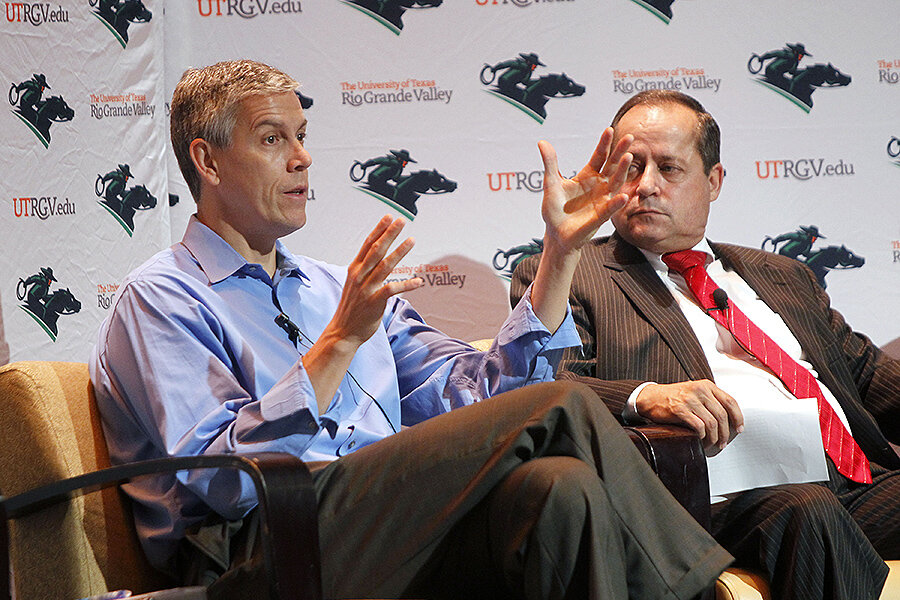More than 1,000 racism complaints at US colleges. What happened?
Loading...
Since Barack Obama's 2008 inauguration, a moment that optimists at the time suggested would herald a healing of race relations in the United States, more and more students and staff have filed complaints of racial harassment with the Department of Education: 1,073 in total, an average of 134 per year, compared to about 50 annually during the previous administration.
Yet, as Inside Higher Ed reports, fewer than 25 percent of those complaints resulted in substantive closure, a category which includes cases where the college agreed to changes, as well as cases for which investigators found insufficient evidence.
University students and staff may file – or drop – racial harassment charges for a variety of reasons, many of which have nothing to do with an increase or decrease in actual racism on campus, such as the time elapsed since the incident, a decision to file a lawsuit instead, or simply the increased awareness that one can file such a complaint, for example.
But as Scott Jaschik writes for IHE, those hundreds of 'dead-end' complaints "may illustrate why students are turning to campus protests and not to Washington with their grievances."
As race-related movements make news at schools across the country, from University of Missouri President Timothy Wolfe's ouster to Princeton students' demands to rename the Woodrow Wilson School of Public and International Affairs, word of high-profile incidents spreads quickly: the Mizzou student president's allegation that peers hurled a racist slur from a pick-up truck, for example, or a University of Kansas professor's suspension for using one in class.
But the DOE's Office of Civil Rights complaints help shed light on the types of experiences many minority students say are pejorative, and harming their educations: a professor whose "comedy routine" made fun of African-Americans, for instance, or a security guard who seemed especially suspicious of students of color.
According to the Office of Civil Rights, "Anyone who believes that an education institution that receives federal financial assistance has discriminated against someone on the basis of race, color, national origin, sex, disability, or age" may file a complaint within 180 days, or, if they have also complained to the school itself, within 60 days of that process' resolution.
Frequently, Jaschik reports, "the college agrees to 'early' resolution, which ends the actual investigation if the college agrees to take various steps. Many of the steps involve clarifying anti-discrimination rules, and not necessarily the specific grievance that led to the complaint."
But whether complaints come from the OCR, or directly to school administrators, they frequently create short-term crises, and long-term dilemmas, for colleges. As Secretary of Education Arne Duncan wrote in a recent op-ed for the St. Louis Post-Dispatch, the Department of Education convened higher ed leaders in Chicago this month to create a list of recommendations.
"There is no place on our college campuses for racial hostility and prejudice that impact our students’ ability to learn," Secretary Duncan writes, while acknowledging the difficulty of distinguishing between free expression and "hostile environments" or "threatening speech."
Among the group's recommendations are campus value statements, diverse faculty, teaching "cultural competency," and timely responses to student complaints.
Multiple university presidents, deans, and advisors have underscored the importance of quickly acknowledging campus issues, a habit some say could have prevented the University of Missouri's allegations of bias from developing so dramatically.
The best time to address campus climate: before it becomes a widespread problem.
"You don't start talking about it when an incident happens," University of Mississippi general counsel Lee Tyner told the Associated Press.
His advice is seconded by Benjamin Reese, president of the National Association of Diversity Officers in Higher Education, who recommends that administrations have a response plan and, better yet, take the initiative to discuss potential issues with students, and not be afraid to show their solidarity with movements they support.
"The first goal is to listen to what students have to say," said University of Nebraska President Hank Bounds, who attended a Black Lives Matter event on campus this month. "Everyone brings a different set of circumstances, and this is an educational institution that should lend itself to learning from one another."
On November 19, Brown University President Christina H. Paxson announced a 10-year, $100 million plan to protect and develop institutional diversity over the long haul, particularly by boosting meaningful internships, fellowships, and professional development opportunities for not just undergraduates, but promising minority PhDs and young professors.
"Although we cannot solve these problems globally, we can ensure that all members of our community are treated with dignity and respect, and are provided the opportunities they need to reach their full human potential. We can make sure that Brown is a place where these issues are acknowledged and better understood through the courses we teach and the scholarship we conduct," Dr. Paxson wrote in a community letter.
Those who have been victimized may want administrators to acknowledge their personal experience, whether via federal complaint, campus protest, or a talk with the school president, but many say they want to ensure the problem won't happen to future students, either, leading their colleges to make long-term investments in campus culture.
"Mizzou seems to have catalyzed years of tension over inequality and race," Huffington Post editors wrote this month. "There's no single switch colleges can flip ... improving racial tensions on campuses will likely take years."
Editor's note: An earlier version of this article stated that few students resolved their cases through the DOE. The vast majority of cases have been "resolved," but not "substantively closed."








